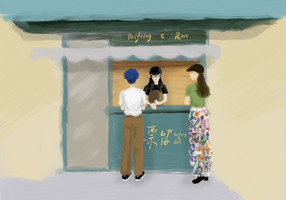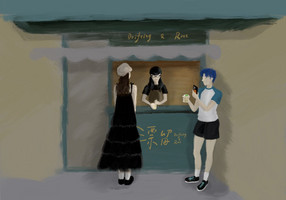Postmortem






This is my first step towards a narrative-focus game, as well as my first attempt at writing a formal script for a (mostly) complete story. While the narrative arc within the game is finished, the story of Shuri and Aoi surely continues beyond the screen.
Original Design
At the beginning, I aimed to deliver the story using as many playable mechanics as possible, believing I could take full advantage of Unity’s flexibility. Inspired by games like Florence, I was especially excited about the idea of progressing the narrative with minimal dialogue.
My initial plan involved a two-perspective structure. The player would control Shuri, choosing what to say and do, while Aoi’s thoughts would be revealed through her diaries. These diaries would contain hidden clues—keywords and fragments expressing emotions that suggest Aoi’s feelings go beyond friendship. The player's challenge would be to choose the most fitting responses while also uncovering all the emotional cues in Aoi’s diaries to unlock the True Ending.
However, the final version of the project became much simpler. Many design elements had to be revised or removed due to scope and time limitations, as I’ll discuss in the following sections. The contrast between the original concept and the final result reflects the learning process and decision-making I experienced throughout the project.
Narrative Design and Endings
The story remains to unfold through two perspectives. Shuri’s inner thoughts are fully visible to the player, revealing her affection, hesitation, and impulsive desires, while Aoi’s feelings are expressed indirectly through her diaries, some of which are only unlocked based on prior choices.
To reach the True Ending, players must carefully navigate Shuri’s emotional journey: balancing silence with the courage to act. A mistimed confession could damage their friendship. Shuri treasured the encounter with Aoi so much that she is willing to preserve their connection even only as a friend.
The three main endings are shaped by Shuri’s emotional state:
• Bad Ending 1 ("Cigarette") results from overly impulsive behavior, where everything burns out too quickly and leaves behind only smoke and ashes.
• Bad Ending 2 (“Senko Hanabi”, a Japanese sparkler) comes from excessive restraint, where mutual feelings remain unspoken, and the relationship fades with the end of summer—bittersweet and quiet, like the final flicker of a senko hanabi (線香花火).
• The Good (“Summer Drifting”) and True Endings (“Rooted Souls”) require the player to find a balance. The key moments are whether Shuri orders Unspoken Love during blackout night and chooses to share her past experience of loving a girl in Chapter 4, a scene not accessible in all playthroughs, depending on earlier choices.
Each choice in the game reflects one of three emotional tones: impulsive, withdrawn, or well-paced. The system is designed to reward emotional awareness over mechanical optimization. Aoi’s diaries subtly guide the player toward more thoughtful decisions, offering a pathway to understanding—and connection.
What Went Right
Throughout this project, I found strength in making thoughtful design choices that enhanced emotional expression and also ensured the project's completion within the limits of time and skill.
1. Using symbolic details to enrich the narrative.
I paid attention to symbolic elements to deepen the emotional layers of the story, such as the characters’ names and the drink menu. Aoi, meaning “blue” (her hair colour) and also “sunflower” in Japanese, reflects her gentle nature and how Shuri sees her: bright and warm. Shuri contains the kanji for “red”(朱) and can be read as Akari, meaning “light”, symbolizing the sun that draws Aoi in. The name of bar Drifting & Root is also interpreted in names of good and true endings which I found smart. The drink Unspoken Love embodies Shuri’s emotional state and directly affects the game’s outcome. The name of Aoi’s order also carries meaning, which can be read as subtle responses to Shuri’s feelings. What’s interesting is that both girls put some secret thought into their drink choices, yet they each use the ingredients as an excuse to cover their true intentions.
2. Structuring the narrative around a single, recurring location.
To avoid the story becoming boringly long and fragmented, I decided to condense the story by focusing the emotional progression on three key visits to the bar Drifting & Root. They still know little about each other on the first visit in Chapter 1; become more ambiguous in the surprised blackout in Chapter 3; and the final confession in Chapter 5. There are two more key events that make them closer in Chapters 2 and 4, and others were skipped and briefly summarized in Aoi’s diaries.
3. Leaning into strengths in writing and visual storytelling.
While thinking about new mechanics and implementing them in code were challenging for me, I found that using environmental cues and visuals to convey emotion and narrative flow came much more naturally. Therefore, I quickly gave up on minimizing text but focused on expressive writing and illustration to carry the emotional weight of each scene.
4. Making efficient visual decisions.
Knowing that drawing is time-consuming, I strategically chose to reuse a single summer sky illustration across multiple scenes by altering its colour and tone to represent day, sunset, and night. I also experimented with editing low-resolution filtered photos and painting over them to create consistent images, which saved significant production time while maintaining aesthetic cohesion.
5. Designing variables based on emotional tone rather than traditional “affection points.”
Instead of using a classic relationship point system, I designed branching outcomes based on three emotional states of Shuri. Choices are mapped to these emotional tones, making the system reflect Shuri’s inner journey rather than a gamified metric.
6. Ensuring that all dialogue choices are emotionally plausible.
I was careful to make every option feel believable and emotionally supported. There are no obviously “wrong” or out-of-character choices.
7. Staying flexible and pragmatic with technical issues.
When encountering technical limitations in Unity, I gave myself time to troubleshoot— but if a solution didn’t emerge quickly, I opted for simpler alternatives to simulate the intended effect. This helped me preserve the narrative pacing and ensure the project reached completion. For example, I failed to separate the diaries into another system, so I used choice button to illustrate opening and closing of the diary, while the background image shows handwriting style diaries, and the dialogue acts as a reading helper. This way, I don’t have to make another manager for diaries but use the existing one to interpret.
What Went Wrong
1. Incomplete flowchart and unclear variable planning.
I underestimated the difficulty of writing a non-linear story with multiple endings. My initial flowchart wasn’t detailed enough, especially near the endings, where the branching logic became more complex. I didn’t plan out all the variables before starting the scriptwriting. Therefore, I ended up adding and modifying conditions on the fly, which made the process inefficient and confusing. Although I eventually made it work, it took much more time than expected, and even now, some of the variable conditions behind the endings may still lack clarity.
2. Technical constraints due to relying on a basic framework.
I built my project by modifying the Basic Ink Unity Integration demo. While this saved time at the beginning, it also meant that some functions were hard coded in ways I didn’t fully understand. Therefore, certain design ideas had to be abandoned due to these limitations. For example, I wanted to add a 5-second timed choice and design an interactive UI menu, but I had to give them up as it needs to change the basic framework of the ink demo, which is challenging for me. Plus, due to the unexpected amount of time spent on writing the script, in the end, the gameplay became quite limited and closer to a classic visual novel format.
Playtesting
I consistently playtested in inky. It not only helped me catch grammar errors, Ink code issues, and check the correctness of branching logic through Inky. It also allowed me to reflect on the readability of the narrative and the clarity of each choice. Feedback from friends was especially helpful, they pointed out moments where inner thoughts felt vague or options were hard to interpret. Their feedback helped me improve emotional clarity and ensure the choices felt intuitive and emotionally grounded.
The End
Through building Summer Drifting, I explored not only a story I care about, but also my own process as a narrative designer. I produced much more drawings for this project than I thought I could, and also tried to add music to help with the narrative.
Files
Summer Drifting
A queer story about love with restraint.
| Status | Prototype |
| Author | Nekopyun |
| Genre | Visual Novel, Role Playing |
| Tags | 2D, Colorful, Hand-drawn, Lesbian, Narrative, Queer, Singleplayer |
